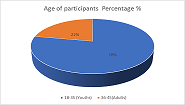Determinants of Alcohol Abuse among Women of Child-Bearing Age in Eastern Province, Zambia- A Cross Sectional Study

Abstract:
Research shows that alcohol use among
women is increasing. While alcohol misuse by
anyone presents serious public health concerns, women who drink have a higher risk
of certain alcohol-related problems compared to men. Alcohol consumption in
childbearing women is a public health concern because of adverse
health implications for the mother and baby. The aim of this
study was to explore the determinants of abuse of alcohol among women of age group
of 18-45 in Ukwimi area of Lusangazi District, Eastern province, Zambia. A cross
sectional study was conducted at Ukwimi-A Rural health centre and surrounding community. A
sample size of 165 respondents was selected using simple random sampling and data
on alcohol abuse in women of child-bearing age was collected
using structured questionnaires. From the 165 participants who took alcohol, 78%
were youths and 22% adults. 56% were married, 40.4% were single 3% were divorced
and 0.6% were widowed. 77% of respondents started to take alcohol due to peer influence and the least, 11% it was due to curiosity.
59% of the respondents had drinking places opened before 10:00 hours and 41% the
drinking places opened at or after 10:00 hours. Majority of the women in the study
expressed some knowledge on what alcohol abuse is and
at the same time were aware of the adverse effects that come with the abuse of alcohol.
Alcohol abuse among women of child-bearing age is still on the rise and the majority
are the youths.
Keywords: Alcohol abuse, Alcohol
misuse, Alcohol consumption, Adverse, peer influence, child-bearing age.
References:
[1] Hammerstein
N, Paul R. 2017. Increasing problem of alcohol abuse among the Zambian population
in the psychiatric setting. Available: http://znphi.co.zm/thehealthpress/wp-content/uploads/2017/07/THPZ_V1_I4.6.pdf.
[2] World Health
Organization. 2015. Global health risks: mortality and burden of disease attributable
to selected major risks. URL http://www.who.int/healthinfo/global_burden_disease/GlobalHealthRisks_report_full.pdf.
[3] Mezquita
L, Stewart S, Ibáñez M, Ruipérez M, Villa H, Moya J. et al. 2011. Drinking motives
in clinical and general populations. European Addiction Research. 17 (5):250-61.
[4] Rehm J,
Samokhvalov A, Neuman M, Room R, Parry C, Lönnroth K.et al. 2009. The association
between alcohol use, alcohol use disorders and tuberculosis (TB). A systematic review.
BMC public health. 9(1):450.
[5] Ezzati,
M. 2004. Comparative Quantification of Health Risks: Sexual and Reproductive Health.
Vol. 2. Geneva, Switzerland: World Health Organization.
[6] Babor, T.
2010. Alcohol: No Ordinary Commodity: Research and Public Policy. Oxford, England:
Oxford University Press.
[7] Babor, T.
Campbell, R. Room, C, and Saunders, J. 1994. A Lexicon of Alcohol and Other Drugs
Terms. Geneva, Switzerland: World Health Organization.
[8] Babor, T.
Higgins-Biddle, J. Saunders, B and M. G. Monteiro. 2001. AUDIT: The Alcohol Use
Disorders Identification Test: Guidelines for Use in Primary Care. World Health
Organization: Geneva, Switzerland.
[9] Fisher,
J. Bang, H and Kapiga. S. 2007. “The Association between HIV Infection and Alcohol
Use: A Systematic Review and Meta-Analysis of African Studies.” Sexually Transmitted
Diseases 34(11):856-863.
[10] Clausen,
T. Rossow, N. Naidoo, K and Kowal, J. 2009. “Diverse Alcohol Drinking Patterns in
20 African Countries.” Addiction 104(7):1147-1154.
[11] Gallo, M.
Behets, M. Steiner, M. Hobbs, T. Hoke, K and Van Damme, L. 2006. “Prostate-s Specific
Antigen to Ascertain Reliability of Self-Reported Coital Exposure to Semen.” Sexually
Transmitted Diseases 33(8):476-479.
[12] Fisher,
J. Cook, K and Kapiga. S. 2010. “Alcohol Use before Sex and HIV Risk: Situational
Characteristics of Protected and Unprotected Encounters among High-Risk African
Women.” Sexually Transmitted Diseases 37(9):571-578.
[13] Bowling,
A. 2005. “Mode of Questionnaire Administration Can Have Serious Effects on Data
Quality.” Journal of Public Health 27(3):281-291.
[14] Bradley,
K. Boyd-Wickizer, S. Powell, H and Burman, H. 2008. “Alcohol Screening Questionnaires
in Women: A Critical Review.” The Journal of the American Medical Association 280(2):166-171.
[15] Bush, K.
Kivlahan, M. McDonnell, S and K. A. Bradley. 1998. “The Audit Alcohol Consumption
Questions (Audit-C): An Effective Brief Screening Test for Problem Drinking.” Archives
of Internal Medicine 158(16):1789-1795.
[16] Cass well,
S and T. Huckle. 2011. “Alcohol’s Harm to Others: Reduced Wellbeing and Health Status
for Those with Heavy Drinkers in their Lives.” Addiction 106(6):1087-1094.
[17] Chersich,
M., and H. Rees. 2010. “Causal Links between Binge Drinking Patterns, Unsafe Sex
and HIV in South Africa: It’s Time to Intervene.” International Journal of STD &
AIDS 21(1):2-7.

